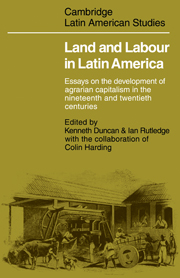 Land and Labourin Latin America
Land and Labourin Latin America Book contents
- Frontmatter
- Contents
- List of tables
- List of figures
- List of maps
- Acknowledgements
- 1 Introduction: patterns of agrarian capitalism in Latin America
- PART I THE TRANSITION FROM TRADITIONAL HACIENDA TO CAPITALIST ESTATE
- PART II THE DEVELOPMENT OF A PLANTATION ECONOMY WITH LABOUR RECRUITMENT FROM HIGHLAND PEASANT COMMUNITIES
- PART III THE DEVELOPMENT OF COMMERCIAL AGRICULTURE USING EUROPEAN IMMIGRANT LABOUR
- PART IV THE TRANSITION FROM SLAVE PLANTATION TO CAPITALIST PLANTATION
- 14 The consequences of modernization for Brazil's sugar plantations in the nineteenth century
- 15 From banguê to usina: social aspects of growth and modernization in the sugar industry of Pernambuco, Brazil, 1850–1920
- 16 The evolution of rural wage labour in the Cauca Valley of Colombia, 1700–1970
- 17 The post-emancipation origins of the relationships between the estates and the peasantry in Trinidad
- PART V POSTSCRIPT
- Glossary of Spanish and Portuguese terms used in the text
- Weights and measures
- Notes on contributors
- Indexes Subjects
- Authors
14 - The consequences of modernization for Brazil's sugar plantations in the nineteenth century
Published online by Cambridge University Press: 07 May 2010
- Frontmatter
- Contents
- List of tables
- List of figures
- List of maps
- Acknowledgements
- 1 Introduction: patterns of agrarian capitalism in Latin America
- PART I THE TRANSITION FROM TRADITIONAL HACIENDA TO CAPITALIST ESTATE
- PART II THE DEVELOPMENT OF A PLANTATION ECONOMY WITH LABOUR RECRUITMENT FROM HIGHLAND PEASANT COMMUNITIES
- PART III THE DEVELOPMENT OF COMMERCIAL AGRICULTURE USING EUROPEAN IMMIGRANT LABOUR
- PART IV THE TRANSITION FROM SLAVE PLANTATION TO CAPITALIST PLANTATION
- 14 The consequences of modernization for Brazil's sugar plantations in the nineteenth century
- 15 From banguê to usina: social aspects of growth and modernization in the sugar industry of Pernambuco, Brazil, 1850–1920
- 16 The evolution of rural wage labour in the Cauca Valley of Colombia, 1700–1970
- 17 The post-emancipation origins of the relationships between the estates and the peasantry in Trinidad
- PART V POSTSCRIPT
- Glossary of Spanish and Portuguese terms used in the text
- Weights and measures
- Notes on contributors
- Indexes Subjects
- Authors
Summary
In the late nineteenth century, two crises disturbed the Brazilian sugar economy. A serious market crisis arose when European beet sugar usurped traditional cane sugar markets. A serious social crisis arose within Brazil when the Imperial government moved to abolish slavery. This study examines the sugar planters’ means of dealing with these crises, why they failed in comparison with Cuban sugar planters, and how they nevertheless succeeded in preserving their social position. It also speculates on how the market crisis might have been overcome and how the social crisis might have been handled differently.
The Brazilian planters attempted capital improvements and reorganization of production to cope with the market crisis, but they failed. The only real solution would have been integration into a northernhemisphere market via recolonization, but that would have entailed heavy political costs. The planters coped better with the social crisis. They succeeded in transferring the losses suffered in export markets to the plantation work force in the form of depressed wages and poor working conditions. Their efforts, aided with government subsidies, perpetuated their dominance in Brazil's sugar areas. Thus ‘modernization’, understood as technological advance and the abolition of forced labour, failed to produce general changes.
The economic crisis
The market crisis affected all cane sugar producers, who had lost about one-half of the world market by the end of the century (Table 51). The shift away from cane sugar consumption did not reflect changing tastes, for cane sugar and beet sugar were good substitutes. In fact, the volume of world cane sugar production increased fivefold during the latter part of the nineteenth century.
- Type
- Chapter
- Information
- Land and Labourin Latin AmericaEssays on the Development of Agrarian Capitalism in the nineteenth and twentieth centuries, pp. 345 - 368Publisher: Cambridge University PressPrint publication year: 1978
- 2
- Cited by


